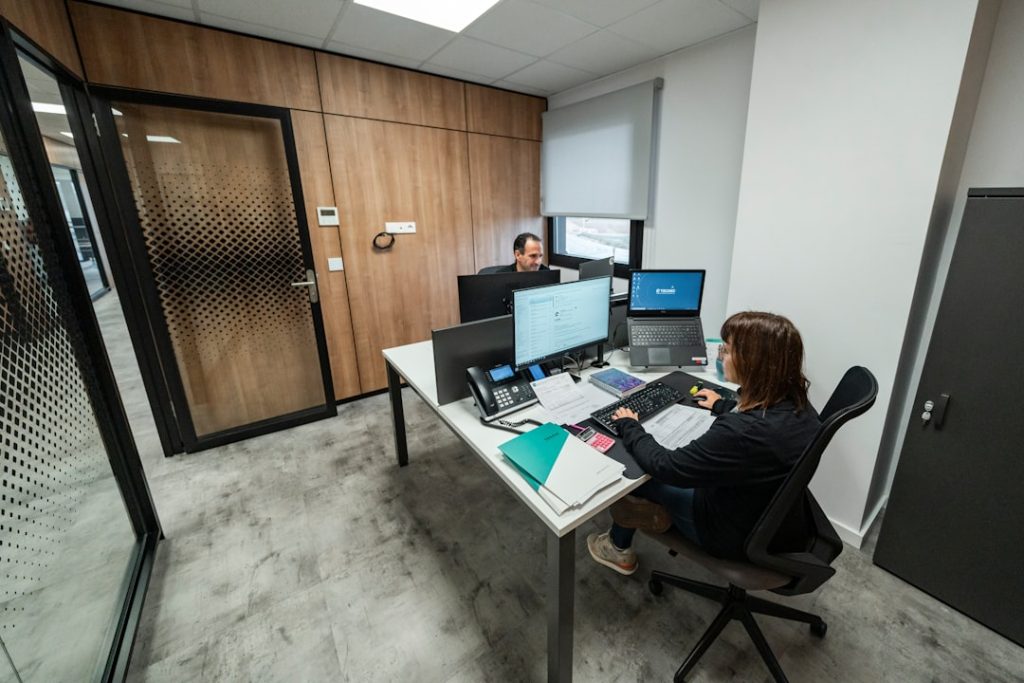Creating an efficient home office space is foundational for productivity and focus. The first step in this process is selecting the right location within your home. Ideally, this should be a quiet area with minimal distractions, allowing for concentration and creativity.
Natural light can significantly enhance the work environment, so positioning your desk near a window can improve mood and energy levels. Additionally, consider the ergonomics of your workspace; investing in a comfortable chair and desk that promote good posture can prevent physical strain and enhance your ability to work for extended periods. Once the location is established, it’s essential to equip the space with the necessary tools and technology.
A reliable computer, high-speed internet connection, and essential software are non-negotiable for any home office. Beyond the basics, consider adding organizational tools such as filing cabinets, shelves, or even digital organization systems to keep your workspace clutter-free. Personal touches, like plants or artwork, can also make the environment more inviting and stimulating.
The goal is to create a space that not only meets functional needs but also inspires creativity and productivity.
Key Takeaways
- Choose a quiet and well-lit area in your home for your office space, and invest in ergonomic furniture to support your posture and comfort.
- Use video conferencing tools and project management software to stay connected with your team and track progress on tasks and projects.
- Set specific work hours and break times to maintain a sense of structure and discipline in your daily routine.
- Use time blocking and the Pomodoro technique to stay focused and manage your time effectively throughout the day.
- Prioritize tasks based on urgency and importance, and delegate when necessary to avoid feeling overwhelmed by your workload.
Utilizing technology for seamless communication and collaboration
In today’s digital age, technology plays a pivotal role in facilitating communication and collaboration among remote teams. Tools such as video conferencing platforms—like Zoom or Microsoft Teams—allow for face-to-face interactions that can replicate the dynamics of in-person meetings. These platforms often come equipped with features such as screen sharing and virtual whiteboards, which can enhance collaborative efforts by allowing team members to brainstorm and visualize ideas in real-time.
The ability to record meetings also ensures that those who cannot attend can catch up later, maintaining continuity in communication. Moreover, project management tools like Trello or Asana can streamline workflows by providing a centralized platform for task assignments and progress tracking. These tools enable team members to see who is responsible for what, set deadlines, and monitor project milestones.
Integrating communication apps like Slack or Microsoft Teams can further enhance collaboration by allowing for instant messaging and file sharing, reducing the reliance on email chains that can become cumbersome. By leveraging these technologies, teams can maintain a high level of engagement and productivity, regardless of their physical locations.
Establishing a structured daily routine and schedule

A structured daily routine is crucial for maintaining focus and productivity while working from home. Establishing a consistent start time each day helps signal the brain that it’s time to transition into work mode. This routine should include not only work hours but also designated breaks to recharge.
For instance, implementing the Pomodoro Technique—working for 25 minutes followed by a 5-minute break—can enhance concentration while preventing burnout. Scheduling these breaks into your day ensures that you step away from your desk regularly, which is vital for both mental clarity and physical health. In addition to work hours, incorporating personal rituals into your routine can create a sense of normalcy.
This might include morning exercises, meditation, or even a simple cup of coffee before diving into tasks. Structuring your day around these rituals can help create a boundary between work and personal life, making it easier to switch off at the end of the day. Furthermore, using digital calendars to block out time for specific tasks can provide visual cues that keep you on track throughout the day.
Implementing effective time management techniques
| Technique | Description | Benefits |
|---|---|---|
| Prioritization | Identifying and focusing on the most important tasks | Increased productivity and efficiency |
| Goal Setting | Setting clear and achievable goals | Improved focus and motivation |
| Time Blocking | Allocating specific time slots for different tasks | Reduced multitasking and better time management |
| Eliminating Time Wasters | Avoiding activities that do not contribute to goals | More time for important tasks |
Effective time management is essential for maximizing productivity in a home office setting. One popular technique is time blocking, where you allocate specific blocks of time for different tasks or projects throughout your day. This method not only helps in organizing your workload but also minimizes distractions by creating dedicated periods for focused work.
For example, you might block out mornings for deep work on complex projects while reserving afternoons for meetings and collaborative tasks. This structured approach allows you to harness your peak productivity hours effectively. Another valuable technique is the Eisenhower Matrix, which helps prioritize tasks based on urgency and importance.
By categorizing tasks into four quadrants—urgent and important, important but not urgent, urgent but not important, and neither urgent nor important—you can make informed decisions about where to focus your efforts. This method encourages you to tackle high-priority tasks first while delegating or eliminating less critical ones. By implementing these time management techniques, you can create a more organized workflow that enhances efficiency and reduces stress.
Prioritizing tasks and managing workload effectively
Prioritizing tasks is a critical skill in managing workload effectively, especially in a remote work environment where distractions abound. One effective strategy is to create a daily or weekly to-do list that ranks tasks based on their deadlines and significance. This list should be dynamic; as new tasks arise or priorities shift, it should be updated accordingly.
Utilizing tools like digital task managers can help keep this list organized and accessible from any device, ensuring that you always have a clear view of what needs to be accomplished. Additionally, understanding the concept of “deep work” versus “shallow work” can aid in prioritization efforts. Deep work refers to tasks that require significant cognitive effort and focus—such as writing reports or developing strategies—while shallow work includes routine tasks like responding to emails or scheduling meetings.
By identifying which tasks fall into each category, you can allocate your most productive hours to deep work while reserving less demanding times for shallow tasks. This strategic approach not only enhances productivity but also ensures that high-impact work receives the attention it deserves.
Fostering a healthy work-life balance

Fostering a healthy work-life balance is essential for long-term success in a remote working environment. One of the most effective ways to achieve this balance is by setting clear boundaries between work and personal life. This could mean designating specific work hours during which you are fully focused on professional responsibilities while ensuring that personal time is equally respected.
Communicating these boundaries with colleagues can help manage expectations regarding availability and responsiveness. Incorporating self-care practices into your daily routine is another vital aspect of maintaining balance. Regular physical activity, mindfulness practices such as meditation or yoga, and ensuring adequate sleep are all crucial components of overall well-being.
Taking time for hobbies or social interactions outside of work can also provide necessary mental breaks and rejuvenation. By prioritizing self-care alongside professional responsibilities, individuals can cultivate resilience against stress and enhance their overall quality of life.
Utilizing performance metrics and data analysis for continuous improvement
In an increasingly data-driven world, utilizing performance metrics can significantly enhance individual and team productivity in a remote setting. Establishing key performance indicators (KPIs) relevant to specific roles allows employees to track their progress against defined goals. For instance, sales teams might monitor metrics such as conversion rates or customer engagement levels, while project teams could focus on deadlines met or project completion rates.
Regularly reviewing these metrics provides insights into areas of strength as well as opportunities for improvement. Data analysis can also inform decision-making processes within teams. By analyzing trends over time—such as productivity fluctuations during different times of the day or week—teams can identify patterns that may inform adjustments in workflow or scheduling.
For example, if data shows that team members are more productive in the mornings, it may be beneficial to schedule critical meetings during those hours while reserving afternoons for less intensive tasks. This continuous feedback loop fosters an environment of growth and adaptation, ultimately leading to enhanced performance.
Creating a supportive and collaborative team culture in a remote environment
Building a supportive and collaborative team culture in a remote environment requires intentional effort from both leadership and team members alike. Regular check-ins through video calls or virtual team-building activities can help maintain connections among team members who may feel isolated working from home. These interactions foster camaraderie and trust, which are essential components of effective collaboration.
Celebrating achievements—whether big or small—can also contribute to a positive team culture by recognizing individual contributions within the larger context of team goals. Encouraging open communication is another critical aspect of fostering collaboration in remote settings. Creating channels where team members feel comfortable sharing ideas, feedback, or concerns promotes transparency and inclusivity.
Utilizing collaborative tools such as shared documents or brainstorming platforms allows everyone to contribute their perspectives regardless of location. By prioritizing these elements within a remote team culture, organizations can cultivate an environment where collaboration thrives, leading to enhanced creativity and innovation across projects.



